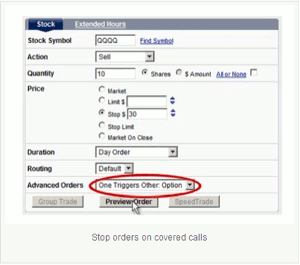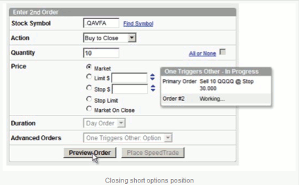Successful covered call writing requires the appropriate use of exit strategies to mitigate losses and enhance gains, writes Alan Ellman of TheBlueCollarInvestor.com.
In today’s article, we will focus on actions that can be taken when a stock price declines and capital preservation becomes a concern. Once we enter our covered call position we are in two distinct trades. We are long the stock and short the option. Without the stock, we would be in a naked options position and susceptible to extreme capital risk. As a matter of fact, most brokerages will not allow retail investors naked options trading privileges for our protection and for their own as well (we do live in a litigious society). This means that we must close our short options position first or close both simultaneously. The latter is now possible with the new advanced trading platforms offered by many online discount brokerages. In this article we will discuss two ways to manage our covered call trades with a declining underlying security.
Simultaneous closing of long and short positions: One Triggers Other order (OTO)
After navigating to the stock order form, we enter a sell stop order at a specific price and then select one triggers other from the advanced orders drop down box. Then click preview (highlighted by arrow) to enter the options order entry screen:
We enter a buy-to-close order on the short options position and submit order after previewing it. Here are the logistics as to how this trade executes successfully:
- Since most of us are not approved for naked options trading, we must enter a market order for the closing of the short options position.
- The sell stop of the long stock position is executed first.
- The options order is immediately sent to the trading floor once the long position is closed.
Advantages
- Orders can be entered without having to be in front of our computers monitoring positions.
- Affords protection against catastrophic losses in most cases.
Disadvantages
- Market orders limit our ability to negotiate more favorable option prices when closing the short options position.
- Closing our entire covered call trade may not be the best exit strategy to execute.
- Closing the short options position first will give us the greatest amount of position management flexibility.
Using the 20/10% guideline:
In my books and DVDs I discuss a guideline that I have developed over the years called the 20/10% guideline. I call it a guideline for a reason. You can veer from the exact percentiles a slight amount and still be a successful covered call trader. For example, in bear or volatile market conditions I may spend a little more than 20% or 10% to buy back my options. Here are the steps if the original option sale was for $3:
- Place a limit order to buy back (buy-to-close) the option for $0.60 or less in the first half of the contract and for $0.30 or less in the latter part of the contract.
- Request that your brokerage company send you an email notification if the short position is closed.
- Once the short position has been closed we now own our shares without any obligation.
- We now have the ability to roll down, take no action and look to “hit a double” or re-sell the same option, or close the entire position.
Advantages
- We can negotiate a better options price using the Show or Fill Rule.
- We have much more flexibility as to the type of exit strategy opportunities we can take advantage of.
- Excellent protection against catastrophic loss in most cases (barring a gap down in price on unexpected bad news…remember no earnings reports!)
Disadvantage
- More time required for proper management
Conclusion
Placing stop loss orders on our covered call writing positions can be accomplished using the OTO or one triggers other order or by closing the short options position first and then taking the best appropriate action. The latter will afford more opportunities to raise your profit level if time permits.
By Alan Ellman of TheBlueCollarInvestor.com




















